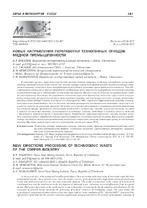Новые направления переработки техногенных отходов медной промышленности

Date
2022Publisher
Another Title
New directions processing of technogenic waste of the copper industry.
Bibliographic entry
Вохидов, Б. Р. Новые направления переработки техногенных отходов медной промышленности = New directions processing of technogenic waste of the copper industry. / Б. Р. Вохидов [и др.] // Литье и металлургия. – 2022. – № 3. – С. 101-107.
Abstract
В настоящее время в горно-металлургической промышленности появились тенденции переработки техногенных отходов, накопившихся в течение многих лет, так как мировые запасы месторождений руд с высоким исходным содержанием цветных металлов и легко перерабатываемыми рудами в настоящее время практически истощены. Это обусловливается уменьшением объема переработки кондиционных руд и вовлечением в разработку техногенных отходов, труднообогатимых руд и забалансовых из низкосортных отвалов. Высокие цены на металлы на мировом рынке создают благоприятную обстановку для разработки технологий извлечения драгоценных металлов с вовлечением в переработку минеральных ресурсов техногенного происхождения. В работе изучены минералогические составы техногенных отходов медной промышленности в условиях АО «Алмалыкский ГМК», определена эффективность методов селективного извлечения платиноидов и уделено внимание способам растворения, восстановления платиновых металлов и методам их очистки от различных примесей. На основе изучения данной тематики и анализа результатов проведенных исследований авторы предложили оптимальную технологию и комплексные способы извлечения платины, палладия и родия из техногенных отходов с использованием селективных методов, подходящих к каждому металлу отдельно с применением гидрометаллургии и пирометаллургии. Разработаны гидрометаллургические способы очистки палладия, платины и родия с обработкой соответственно муравьиной, лимонной и азотной кислотой. В результате разработанных технологий достигнута возможность комплексного извлечения металлов платиновой группы из техногенных отходов. При этом сквозное извлечение всех платиноидов составляет свыше 80 %.
Abstract in another language
At the present time, in the mining and metallurgical industry there are trends in the processing of man-made waste that have accumulated over the course of many years. Since the world’s reserves of ore deposits with a high initial content of non-ferrous metals and easily processed ores are currently practically depleted. This is due to a decrease in the volume of processing of conditioned ores and the involvement in the development of industrial waste, refractory ores and off-balance from low-grade dumps. High prices for metals on the world market create a favorable environment for the development of technologies for the extraction of precious metals involving the processing of mineral resources of technogenic origin. The work studies the mineralogical composition of industrial waste from the copper industry in the conditions of JSC “Almalyk MMC”, determined the effectiveness of methods for the selective extraction of platinoids and paid attention to the methods of dissolution, reduction of platinum metals and methods of their purification from various impurities. Based on the study of this topic and the analysis of the results of the research, the authors proposed an optimal technology and complex methods for extracting platinum, palladium and rhodium from industrial waste using selective methods suitable for each metal separately using hydrometallurgy and pyrometallurgy. Hydrometallurgical methods have been developed for the purification of palladium, platinum and rhodium with treatment, respectively, with formic, citric and nitric acids. As a result of the developed technologies, the possibility of complex extraction of platinum group metals from industrial waste has been achieved. In this case, the end-to-end extraction of all platinoids is over 80 %.
View/
Collections
- № 3[20]
